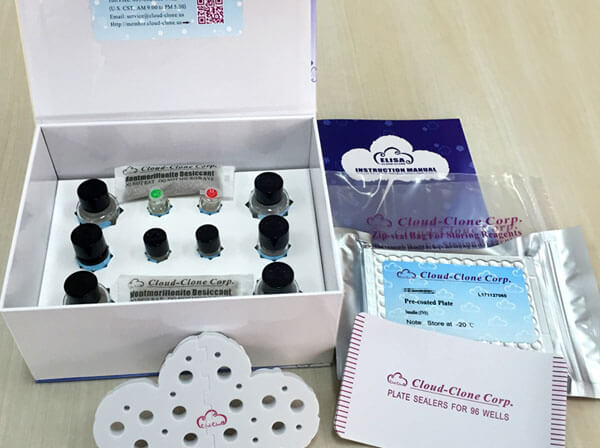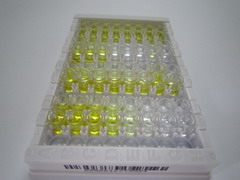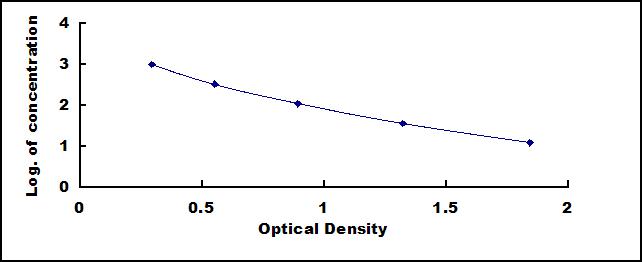ELISA Kit for Gastrin (GT) 

GAST; GAS; Gastrin component I; Big gastrin; Gastrin component II; Gastrin component III
- UOM
- FOB US$ 466.00 US$ 665.00 US$ 2,993.00 US$ 5,653.00 US$ 46,550.00
- Quantity
Overview
Properties
- Product No.CEB224Hu
- Organism SpeciesHomo sapiens (Human) Same name, Different species.
- ApplicationsEnzyme-linked immunosorbent assay for Antigen Detection.
Research use only - DownloadInstruction Manual
- CategoryMetabolic pathwayEndocrinologyGastroenterologyHormone metabolism
Sign into your account
Share a new citation as an author
Upload your experimental result
Review

Contact us
Please fill in the blank.
Recovery
Matrices listed below were spiked with certain level of recombinant Gastrin (GT) and the recovery rates were calculated by comparing the measured value to the expected amount of Gastrin (GT) in samples.
| Matrix | Recovery range (%) | Average(%) |
| serum(n=5) | 89-102 | 93 |
| EDTA plasma(n=5) | 89-104 | 96 |
| heparin plasma(n=5) | 98-105 | 101 |
Precision
Intra-assay Precision (Precision within an assay): 3 samples with low, middle and high level Gastrin (GT) were tested 20 times on one plate, respectively.
Inter-assay Precision (Precision between assays): 3 samples with low, middle and high level Gastrin (GT) were tested on 3 different plates, 8 replicates in each plate.
CV(%) = SD/meanX100
Intra-Assay: CV<10%
Inter-Assay: CV<12%
Linearity
The linearity of the kit was assayed by testing samples spiked with appropriate concentration of Gastrin (GT) and their serial dilutions. The results were demonstrated by the percentage of calculated concentration to the expected.
| Sample | 1:2 | 1:4 | 1:8 | 1:16 |
| serum(n=5) | 80-95% | 99-105% | 82-91% | 92-99% |
| EDTA plasma(n=5) | 89-97% | 88-95% | 79-101% | 99-105% |
| heparin plasma(n=5) | 80-98% | 98-105% | 92-101% | 96-105% |
Stability
The stability of kit is determined by the loss rate of activity. The loss rate of this kit is less than 5% within the expiration date under appropriate storage condition.
To minimize extra influence on the performance, operation procedures and lab conditions, especially room temperature, air humidity, incubator temperature should be strictly controlled. It is also strongly suggested that the whole assay is performed by the same operator from the beginning to the end.
Reagents and materials provided
| Reagents | Quantity | Reagents | Quantity |
| Pre-coated, ready to use 96-well strip plate | 1 | Plate sealer for 96 wells | 4 |
| Standard | 2 | Standard Diluent | 1×20mL |
| Detection Reagent A | 1×120µL | Assay Diluent A | 1×12mL |
| Detection Reagent B | 1×120µL | Assay Diluent B | 1×12mL |
| TMB Substrate | 1×9mL | Stop Solution | 1×6mL |
| Wash Buffer (30 × concentrate) | 1×20mL | Instruction manual | 1 |
Assay procedure summary
1. Prepare all reagents, samples and standards;
2. Add 50µL standard or sample to each well.
And then add 50µL prepared Detection Reagent A immediately.
Shake and mix. Incubate 1 hour at 37°C;
3. Aspirate and wash 3 times;
4. Add 100µL prepared Detection Reagent B. Incubate 30 minutes at 37°C;
5. Aspirate and wash 5 times;
6. Add 90µL Substrate Solution. Incubate 10-20 minutes at 37°C;
7. Add 50µL Stop Solution. Read at 450 nm immediately.

Test principle
This assay employs the competitive inhibition enzyme immunoassay technique. A monoclonal antibody specific to Gastrin (GT) has been pre-coated onto a microplate. A competitive inhibition reaction is launched between biotin labeled Gastrin (GT) and unlabeled Gastrin (GT) (Standards or samples) with the pre-coated antibody specific to Gastrin (GT). After incubation the unbound conjugate is washed off. Next, avidin conjugated to Horseradish Peroxidase (HRP) is added to each microplate well and incubated. The amount of bound HRP conjugate is reverse proportional to the concentration of Gastrin (GT) in the sample. After addition of the substrate solution, the intensity of color developed is reverse proportional to the concentration of Gastrin (GT) in the sample.
Giveaways
Increment services
Citations
- Omeprazole improves the antiobesity and antidiabetic activity of Exendin-4 in db/db mice.PubMed: 22830490
- Liver-Derived Systemic Factors Drive b Cell Hyperplasia in Insulin-Resistant StatesPubMed: PMC3655439
- Lansoprazole enhances the antidiabetic effect of sitagliptin in mice with diet-induced obesity and healthy human subjectsPubmed: 24628303
- Combination of omeprazole with GLP-1 agonist therapy improves insulin sensitivity and antioxidant activity in liver in type 1 diabetic micePubmed: 24145087
- Roles of sphincter of Oddi motility and serum vasoactive intestinal peptide, gastrin and cholecystokinin octapeptideNCBI: PMC4000510
- 清醒状态下热射病大鼠胃肠动力与胃泌素、胃动素的变化Wjgnet:Source
- Effects of sphincter of Oddi motility on the formation of cholesterol gallstonesPubmed:27350732
- Engineering bioinspired bacteria-adhesive clay nanoparticles with a membrane-disruptiveproperty for the treatment of Helicobacter pylori infection.pubmed:27605059
- The Effect of Salt Intake and Potassium Supplementation on Serum Gastrin Levels in Chinese Adults: A Randomized Trialpubmed:28420122
- Positive enhancement of Lactobacillus fermentum HY01 on intestinal movements of mice having constipation10.1007/s13765-017-0327-3
- Protective Effect of Silkworm Pupa Oil on Hydrochloric Acid/Ethanol‐Induced Gastric UlcerPubmed: 30479041
- Ganjiang granule regulates cecal microflora and serum biochemical components in a rat model of constipation-predominant irritable bowel syndrome
- The Inhibitory Effects of Naringin in a Rat Model of Postoperative Intraperitoneal Adhesion FormationPubmed:35069760

















